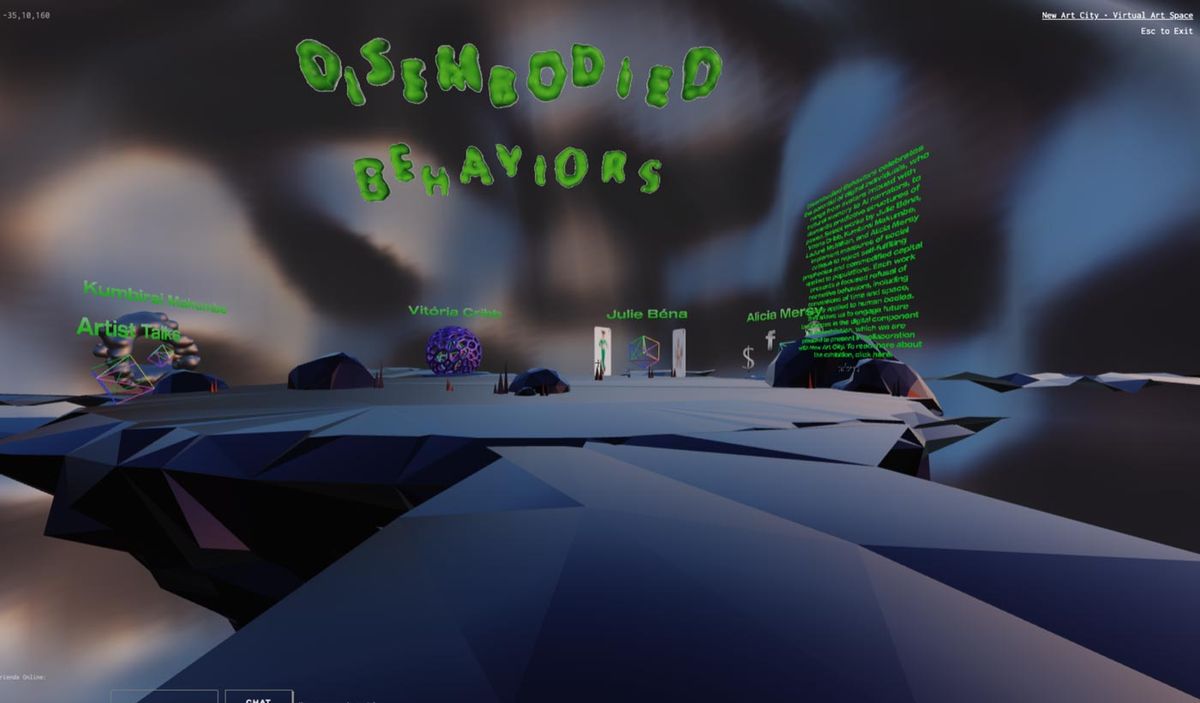What is it:
Virtual exhibition and artist talks presented by bitforms gallery, which specialises in digital, internet, time-based and new media art forms, and curated by Zaiba Jabbar and Valerie Amend. It includes the artists Julie Béna, Vitória Cribb, Kumbirai Makumbe, LaJuné McMillian, and Alicia Mersy. Each artist has a exclusive virtual 3-D room with a digital installation
Platform: New Art City, a multi-user online platform to experience digital art—created in response to the closures of art museums and galleries during the Covid-19 pandemic.
Artists and exhibition designers upload files to New Art City, arrange their space and collaborate in real-time. No coding required.
Exhibition visitors access online via a web browser, with no need to register or instal anything.
Where to Find it
Disembodied Behaviors website.
Curator’s Note
I wanted to enter 2021 with an acknowledgement that the whole point of this column is to push the conversation between art and XR technology. Symbolically, for this review we have forgone our star system in lieu of more open responses to the experienceGretchen Andrew
After a year of teaching our grandparents how to Zoom, we would hardly dispute Oliver Laric’s 2010 assertion that the internet is not a space of representation but of primary experiences.
The year 2020 was one in which we resigned ourselves to screen-mediated people and art. Disembodied Behaviors, curated by Zaiba Jabbar and Valerie Amend for bitforms gallery, gives us both. Importantly, it includes the digital work of non-white artists, who, as we have discussed before, are under-represented in both the tech and art worlds. Disembodied Behaviors is 2020 both as a celebration and a conceit.

Artist talks are hosted in a virtual reality gallery
Notable is bitforms gallery’s use of a virtual space to host artist conversations. At its best, art is a discourse. And while information technology has the potential to facilitate conversations, it is more common to see it degrading them. I wanted to enter 2021 with an acknowledgement that the whole point of this column is to push the conversation between art and XR technology. Symbolically, for this review we have forgone our star system in lieu of more open responses to the experience. Relevantly, New Art City, the platform which hosts the exhibitions and talks, offers a chat box allowing live conversations with anyone else in the virtual space.

Disembodied Behaviors allows users to chat with each other
Unlike most of the experiences we’ve reviewed since July 2020, Disembodied Behaviors is not concerned with digital translation of physical art objects into virtual spaces. It instead presents fully formed digital worlds ungrounded in material reality, though it lived both online and physically at the bitforms gallery in Lower Manhattan. Seeing this digitally native work reminded me how little we have spoken about what this physical to digital translation process conceptually means.
Digitising—whether into VR or through an iPhone camera snap, however hands-off by the artist, however determined by algorithms not written by artists—is an artistic process that sits somewhere between installing work in a gallery and a transformation in the mode of Sherrie Levine’s After Walker Evans (1981). Meaning is always added and lost by the digitisation process. This impacts the moral rights of artists in a way this column will be exploring in depth this year. Stay tuned!
Agreeing with Laric in regards to the internet as a space of experience, I like to think of digitisation in terms of the difference between how language and images operate. Language works through pointers. For example with “pipe” representing a physical pipe but p-i-p-e itself having nothing inherently pipe-like about it. By contrast, a digital photo of Starry Night seen on Instagram may not be the Starry Night just as Van Gogh intended. The meaning it produces is not solely as a language-like pointer to the physical object within MoMA. Images and videos are capable of provoking primary experience but this primary experience is impacted by digital aesthetics defined by technology companies who design smartphones, VR headsets, laptops and tablets.
Aesthetics, from the Greek aisthetikos, means relating to perception by the senses. Unlike language, aesthetics create meaning as a result of bodily interpretations of experience. These physical experiences are often coded with relative racial, political, social, cultural and power positions. Exploring “white/black space” is an investigation of aesthetics. How you act in front of a painting on a white wall is an aesthetic response. It is the result of bodies in contact with each other, of your sensory perceptions running through a conscious and subconscious knowledge of how you, specifically, are to behave.
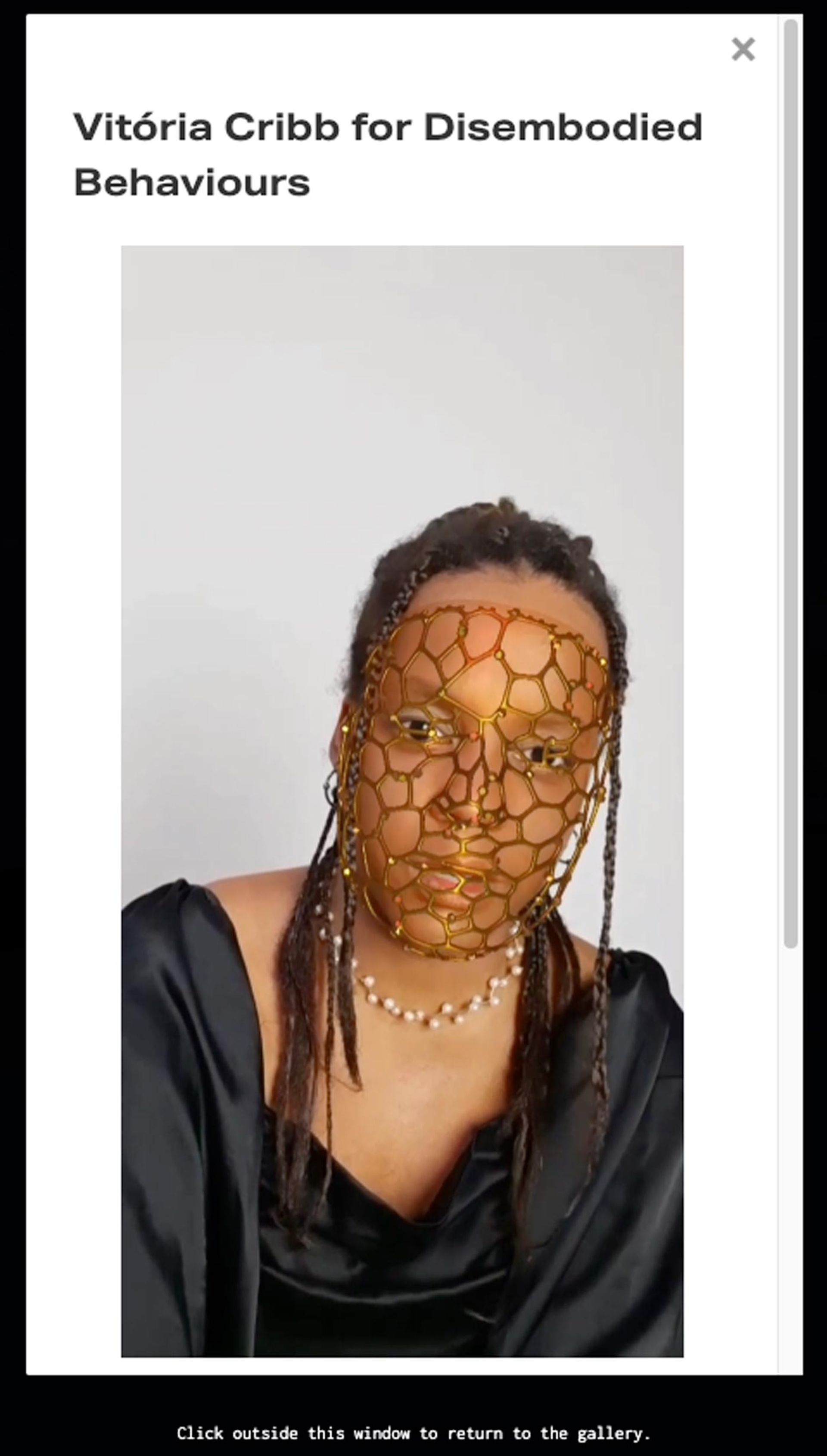
The artist talks are conversational and personal
In 2020, all the art we reviewed was mediated by the mutable and artistically uncontrollable aesthetics of screens and devices. In 2015, I referred to this as the Movable Fetish of digital art. If all art is digitised, what would it mean to define the digital as inevitable instead of just among an artist’s potential tools of creation and public display?
While the digital has an increasingly totalitarian nature, its very elements (screens, bits, the internet) help us distinguish digital art from... the other art stuff. You know, like paint and such.
What is the importance and value of this distinction? Why don’t we talk about that in 2021 as well.
—Gretchen Andrew
They Say:
Disembodied Behaviors celebrates the potential of digital individuals, who range from avatars imbued with cultural memory to AI narrators, to dismantle predictive structures of power.bitforms gallery
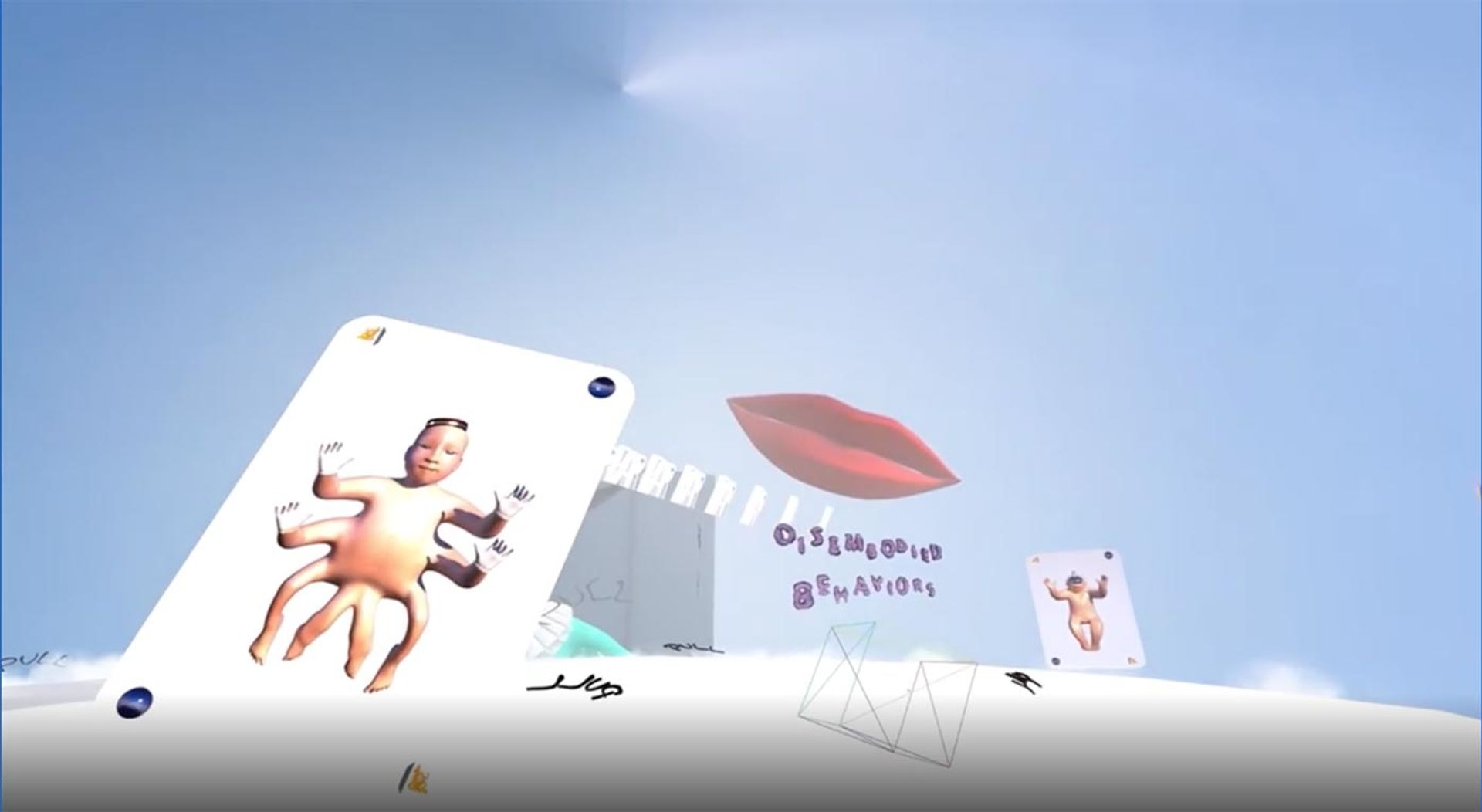
Julie Béna's work on Disembodied Behaviors highlights the inherent dangers of excessive focus on transparency
We Say:
This is the show I’ve been waiting for all yearEron Rauch
Eron Rauch: A recent Alienware computer hardware advertisement has a dreadlocked, hip woman of colour proclaim, “Sometimes I can’t tell myself from my machine. I think that’s by design", as Tron-blue lines armour her, or maybe disassemble her into consumer one-ness with her computer-product.
Loading Disembodied Behaviors, I see asset names shuffle left to right and then my stomach falls as I pause, lurch down into a metallic blob. Standing in the shadow-shimmer cavern, a 2D magenta triangle with the name qv9q27zg54—an avatar of another user in this underworld—punctures the simulated 3D of the screen but refuses to talk to me.
Is it enough to describe either of these experiences as surreal?
“I figure everyone is fluent in surrealism," says the artist Todd Gray, "as a result of music videos, commercials, films, and montage editing”—the modes that Gray uses in works that unsettle racial and colonial narratives.
Yet, in the same way that it is both too literal and too understated to say “crystalline” for the effect of a full-brightness 60-inch glossy LCD screen, “surreal” is both a cliché and too timid a word to describe how unsettlingly mathematically perfect but existentially inhumanly mid-rent 3D CG graphics—which I sometimes call "PlayStation 3-wave"—can be.
Rather than surreal, the insistently computer-generated works in Disembodied Behaviors are “ultra”. (Say it like Generation Z says “extra” for good effect.) The show is an ultra-real ultra-world, one that places you face-to-face with example after example of artworks so precise but so constructed that they sear through the hazy, lazy categories we default to when we construct “the real”, whether they be race, bodies, history, or technology itself.
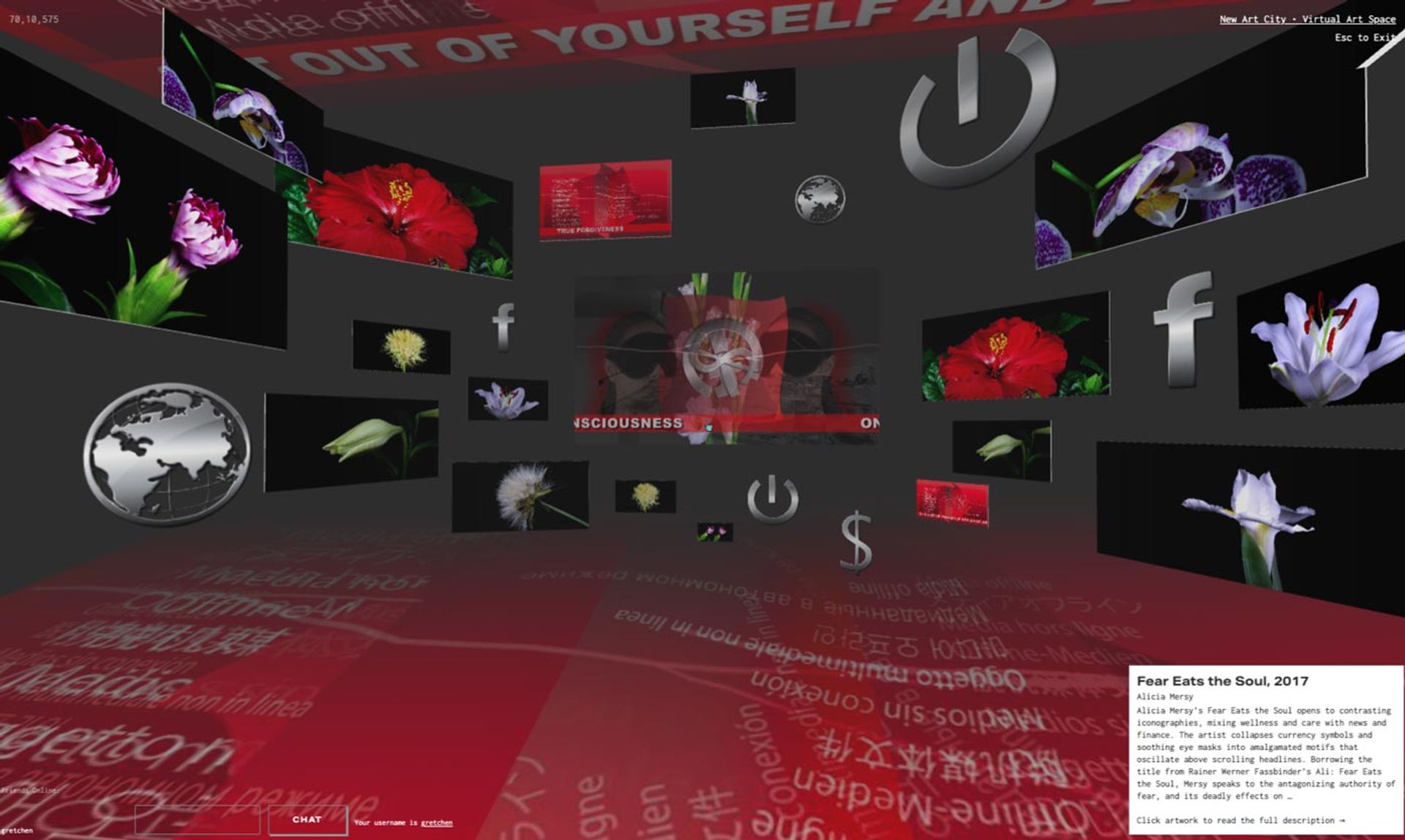
Spatial poetics: Alicia Mersy features her Fear Eats the Soul on Disembodied Behaviors
The spatial term “world”—evoking video game spatial poetics for the show layout—is important in Disembodied Behaviors. Turning art into narratives that change us requires space, both mentally and physically. In a direct challenge to the commonplace passive viewing of gaudy CG from Mind’s Eye to Transformers, throughout Disembodied Behaviors, the ultra-real is an active experience, always mutating with our trajectories through the never-certain bounds between landscape, architecture, bodies, surfaces, screens, artworks, and digital assets from artworks.
“We find a way through images," the poet Naomi Shihab Nye has said, "to be together.” What a radically new “being together” the mesh of ultra-real in Disembodied Behaviors suggests! The clashing, glossy, perfection of imperfection sears the mind-haze of 2020’s unending March back to a state of clarity. Clarity, not to see things as normal, not back to normal as a political slogan, not to let legacy systems of real estate, gender, and race remain normal; but instead, to provide the leverage to perceive the potential for change and un-definition.
This is the show I’ve been waiting for all year.
The artists address the user and expound upon the meaning of their work. The viewer is driven to reflect on how technology appropriates and capitalises on Black bodies and cultureCarole Chainon
Carole Chainon: New Art City’s features are very user friendly, as anyone equipped with the URL and a computer can access the exhibit. With a click, we are propelled into this colourful 360-degree universe with multiple portals representing the different artists and their work.
Click into a portal and a video of Brazilian Black artist Vitória Cribb with a 3D metal mesh on her face describes how we too often view Black bodies as “digital bodies—exploited and reduced like files or software”. Click into another portal and LaJuné McMillian explores the ethical issues that come with digitising and the capitalisation of Black culture and bodies. Kumbirai Makumbe created an AI, embodied as a shapeless, reflective silver form which personifies and celebrates Blackness, while Julie Béna highlights the inherent dangers of excessive focus on transparency.
The artists address the user and expound on the meaning of their work. The viewer is driven to reflect on how technology appropriates and capitalises on Black bodies and culture and points to the conformism that arises from our cultural obsession with transparency.
Pulling data from motion tracking and applying them to avatars is interesting to see in a fine art contextDhiren Dasu
Dhiren Dasu: Vitória Cribb’s immersive layout invited me to investigate her space and ideas. Her work raises interesting questions about linearity vs curvature as a jumping off point to examine our collective role in the digital landscape as data points to be mined, analysed and exploited.
LaJuné McMillan’s Movement Portraits that liquidised, digitised and disintegrated were also visually compelling. Pulling data from motion tracking and applying them to avatars is interesting to see in a fine art context. Her work is beautifully ethereal and dances a fine line between representation and abstraction.
Alicia Mersey’s clever juxtaposition of currency and self-help ticker feed delves into the nexus of commerce, value, advertising, news media and the incessant messaging that we absorb every waking moment in the disembodied digital world that we spend a significant portion of our lives in.
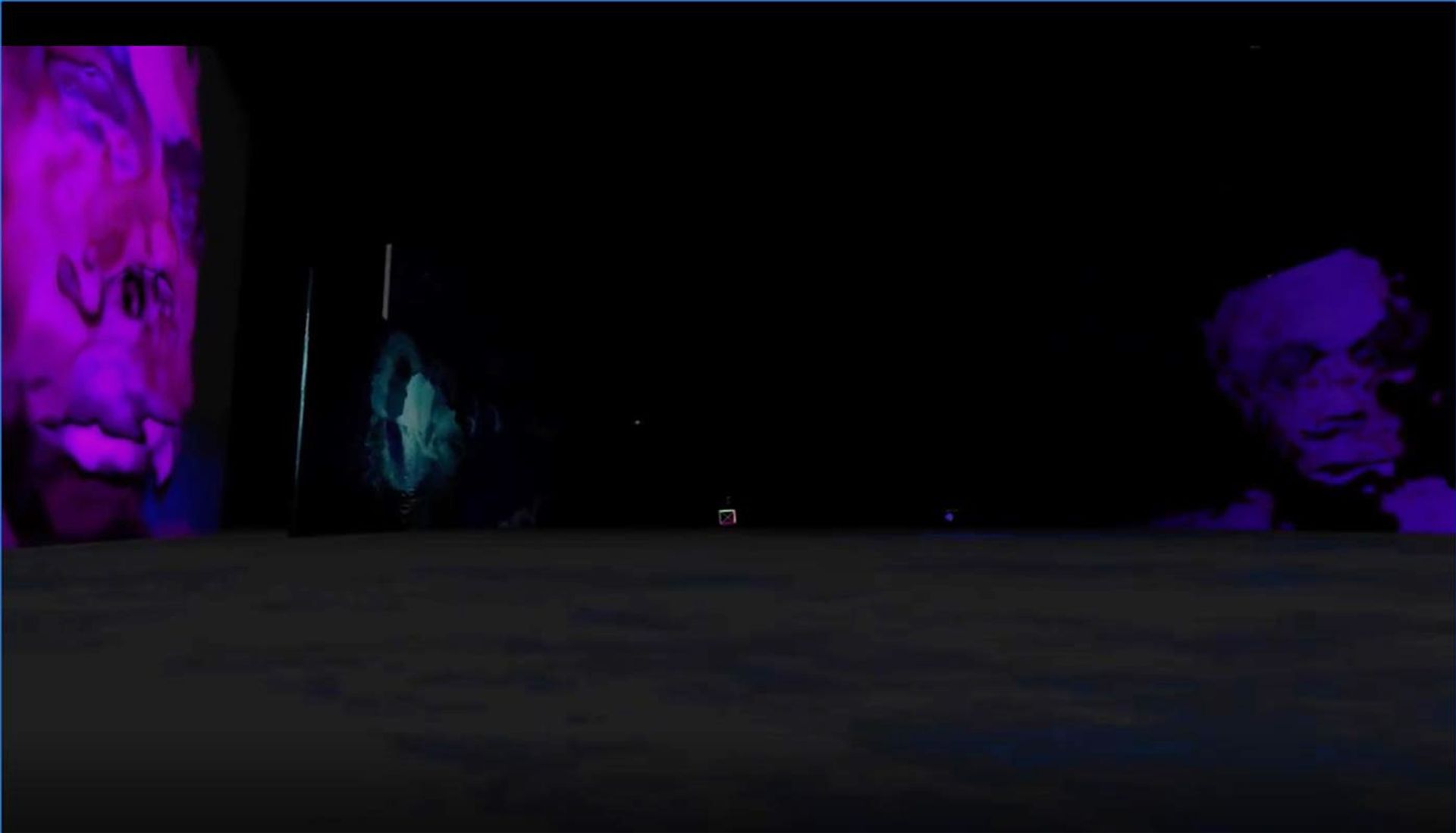
Beautifully ethereal: LaJuné McMillian’s Movement Portraits—Nala
Overall a good show of artists who are working with interesting concepts. However, I felt that the rendition of the VR experience left much to be desired. The interface was awkward and not exactly easy to navigate. The quality of the video clips was jerky and did not translate the art in as fluid a manner as I would hope for. However, since it is a web-based experience that requires no additional software installation or other barrier to entry, I do think it is a good step towards delivering an immersive experience of these artists’ work.
The Art Newspaper’s XR Panel
Gretchen Andrew is a Search Engine Artist and Internet Imperialist who has manipulated the US presidential election with art and desire. Her next exhibition is with Annka Kultys in February 2021.
Eron Rauch is an artist, writer, and curator whose projects explore the infrastructure of imagination, with a focus on subcultures, video games, and photography history.
Dhiren Dasu is a digital media creator and consultant. His areas of speciality include photography, film, virtual space, graphic design, visual effects, animation, and audio production. Dasu, in his fine art persona as Shapeshifter7, makes artworks that echo and recompose the architectural spaces he photographs, turning them into immersive spaces while exploring the nexus of photography, collage, symbols, and perception.
Carole Chainon is the co-founder of JYC, a XR development and production studio based in LA with a presence in Europe, creating XR experiences for the entertainment and enterprise sector. She is also a Spark AR Creator.


